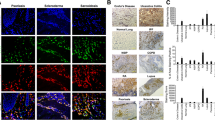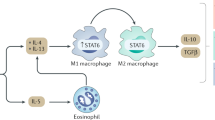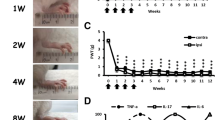Abstract
Macrophages play a central role in the pathogenesis of rheumatoid arthritis (RA). There is an imbalance of inflammatory and antiinflammatory macrophages in RA synovium. Although the polarization and heterogeneity of macrophages in RA have not been fully uncovered, the identity of macrophages in RA can potentially be defined by their products, including the co-stimulatory molecules, scavenger receptors, different cytokines/chemokines and receptors, and transcription factors. In the last decade, efforts to understand the polarization, apoptosis regulation, and novel signaling pathways in macrophages, as well as how distinct activated macrophages influence disease progression, have led to strategies that target macrophages with varied specificity and selectivity. Major targets that are related to macrophage development and apoptosis include TNF-α, IL-1, IL-6, GM-CSF, M-CSF, death receptor 5 (DR5), Fas, and others, as listed in Table 1. Combined data from clinical, preclinical, and animal studies of inhibitors of these targets have provided valuable insights into their roles in the disease progression and, subsequently, have led to the evolving therapeutic paradigms in RA. In this review, we propose that reestablishment of macrophage equilibrium by inhibiting the development of, and/or eliminating, the proinflammatory macrophages will be an effective therapeutic approach for RA and other autoimmune diseases.

Similar content being viewed by others
References
Papers of particular interest, published recently, have been highlighted as: • Of importance •• Of major importance
Mantovani A, Sica A, Sozzani S, et al. The chemokine system in diverse forms of macrophage activation and polarization. Trends Immunol. 2004;25:677–86.
Mosser DM, Edwards JP. Exploring the full spectrum of macrophage activation. Nat Rev Immunol. 2008;8:958–69.
Hamilton JA. Colony-stimulating factors in inflammation and autoimmunity. Nat Rev Immunol. 2008;8:533–44.
•• Hashimoto D, Miller J, Merad M. Dendritic cell and macrophage heterogeneity in vivo. Immunity. 2011;35:323–35. The authors discuss how recent discoveries in the origin of the DC and macrophage lineage help establish key functional differences between tissue DC and macrophage subsets. The authors also emphasize the need to further understand the functional heterogeneity of the tissue DC and macrophage lineages to better comprehend the complex role of these cells in tissue homeostasis and immunity.
•• Hamilton JA, Tak PP. The dynamics of macrophage lineage populations in inflammatory and autoimmune diseases. Arthritis Rheum. 2009;60:1210–21. This is one of the most comprehensive review discussing the macrophage heterogeneity in autoimmunity.
Chow A, Brown BD, Merad M. Studying the mononuclear phagocyte system in the molecular age. Nat Rev Immunol. 2011;11:788–98.
Campbell IK, Rich MJ, Bischof RJ, et al. The colony-stimulating factors and collagen-induced arthritis: Exacerbation of disease by m-csf and g-csf and requirement for endogenous m-csf. J Leukoc Biol. 2000;68:144–50.
Cook AD, Braine EL, Campbell IK, et al. Blockade of collagen-induced arthritis post-onset by antibody to granulocyte-macrophage colony-stimulating factor (gm-csf): Requirement for gm-csf in the effector phase of disease. Arthritis Res. 2001;3:293–8.
Ohno H, Uemura Y, Murooka H, et al. The orally-active and selective c-fms tyrosine kinase inhibitor ki20227 inhibits disease progression in a collagen-induced arthritis mouse model. Eur J Immunol. 2008;38:283–91.
Ando W, Hashimoto J, Nampei A, et al. Imatinib mesylate inhibits osteoclastogenesis and joint destruction in rats with collagen-induced arthritis (cia). J Bone Miner Metab. 2006;24:274–82.
•• Cornish AL, Campbell IK, McKenzie BS, et al. G-CSF and GM-CSF as therapeutic targets in rheumatoid arthritis. Nat Rev Rheumatol. 2009;5:554–9. The authors postulate that antagonism of G-CSF or GM-CSF could represent a novel therapeutic approach for a variety of autoimmune-mediated inflammatory diseases, including rheumatoid arthritis.
Anna Yarilina KX, Chan C, et al. Regulation of macrophage-mediated chronic inflammation by jak inhibitors. Arthritis Res Ther. 2012;14:53–4.
Park-Min KH, Ji JD, Antoniv T, et al. IL-10 suppresses calcium-mediated costimulation of receptor activator nf-kappa b signaling during human osteoclast differentiation by inhibiting trem-2 expression. J Immunol. 2009;183:2444–55.
• Lee SM, Suk K, Lee WH. Synthetic peptides containing itim-like sequences of irem-1 (cd300f) differentially regulate myd88 and trif-mediated tlr signalling through activation of shp and/or pi3k. Clin Exp Immunol. 2012;167:438–46. The authors describe the generation of immunomodulatory molecules that can regulate the inflammatory activation of macrophages.
Ruhmann M, Piccinini AM, Kong PL, et al. Endogenous activation of adaptive immunity: Tenascin-c drives il-17 synthesis in arthritic joint disease. Arthritis Rheum. 2012.
•• Kokkonen H, Soderstrom I, Rocklov J, et al. Up-regulation of cytokines and chemokines predates the onset of rheumatoid arthritis. Arthritis Rheum. 2010;62:383–91. The data show that prior to development of RA, "prepatient" individuals already had significantly increased levels of GM-CSF, M-CSF, and other proinflammatory cytokines and chemokines, indicating activation of the immune. system, as compared with controls, who did not develop RA. After disease onset, the involvement and activation of the immune system was more general and widespread.
Mulherin D, Fitzgerald O, Bresnihan B. Synovial tissue macrophage populations and articular damage in rheumatoid arthritis. Arthritis Rheum. 1996;39:115–24.
Ramprasad MP, Terpstra V, Kondratenko N, et al. Cell surface expression of mouse macrosialin and human cd68 and their role as macrophage receptors for oxidized low density lipoprotein. Proc Natl Acad Sci USA. 1996;93:14833–8.
Strobl H, Scheinecker C, Csmarits B, et al. Flow cytometric analysis of intracellular cd68 molecule expression in normal and malignant haemopoiesis. Br J Haematol. 1995;90:774–82.
Haringman JJ, Gerlag DM, Zwinderman AH, et al. Synovial tissue macrophages: A sensitive biomarker for response to treatment in patients with rheumatoid arthritis. Ann Rheum Dis. 2005;64:834–8.
Van Gorp H, Delputte PL, Nauwynck HJ. Scavenger receptor CD163, a jack-of-all-trades and potential target for cell-directed therapy. Mol Immunol. 2010;47:1650–60.
Philippidis P, Mason JC, Evans BJ, et al. Hemoglobin scavenger receptor cd163 mediates interleukin-10 release and heme oxygenase-1 synthesis: antiinflammatory monocyte-macrophage responses in vitro, in resolving skin blisters in vivo, and after cardiopulmonary bypass surgery. Circ Res. 2004;94:119–26.
Fonseca JE, Edwards JC, Blades S, et al. Macrophage subpopulations in rheumatoid synovium: Reduced cd163 expression in cd4+ t lymphocyte-rich microenvironments. Arthritis Rheum. 2002;46:1210–6.
Bleesing J, Prada A, Siegel DM, et al. The diagnostic significance of soluble cd163 and soluble interleukin-2 receptor alpha-chain in macrophage activation syndrome and untreated new-onset systemic juvenile idiopathic arthritis. Arthritis Rheum. 2007;56:965–71.
Ambarus CA, Krausz S, van Eijk M, et al. Systematic validation of specific phenotypic markers for in vitro polarized human macrophages. J Immunol Methods. 2011;375:196–206.
•• Krausgruber T, Blazek K, Smallie T, et al. Irf5 promotes inflammatory macrophage polarization and th1-th17 responses. Nat Immunol. 2011;12:231–8. The data suggest a critical role for IRF5 in M1 macrophage polarization and define a previously unknown function for IRF5 as a transcriptional repressor.
•• Li J, Hsu HC, Yang P, et al. Treatment of arthritis by macrophage depletion and immunomodulation: testing an apoptosis-mediated therapy in a humanized death receptor mouse model. Arthritis Rheum. 2012;64:1098–109. This is the first demonstration and proof of the principle that an anti-human DR5 apoptosis therapy can be used to prevent and treat arthritis in a CIA mouse model. The authors utilized a novel hu/mo chimeric DR5 mouse to demonstrate the efficacy of an antihuman DR5 therapy and showed that induction of apoptosis of macropghages was the major mechanism of action leading to decreased inflammatory macrophages and Th17 cells and increased Treg cells.
• Parihar A, Eubank TD, Doseff AI. Monocytes and macrophages regulate immunity through dynamic networks of survival and cell death. J Innate Immun. 2010;2:204–15. This review summarizes the contribution of the caspases and their regulators in monocyte/macrophage cell fate and discusses how these molecules orchestrate the initiation, maintenance, and resolution of inflammation. More provocatively, we discuss possible strategies for controling inflammation by manipulating leukocyte life span.
Zhou T, Edwards 3rd CK, Yang P, et al. Greatly accelerated lymphadenopathy and autoimmune disease in lpr mice lacking tumor necrosis factor receptor i. J Immunol. 1996;156:2661–5.
Jacob CO, Aiso S, Michie SA, et al. Prevention of diabetes in nonobese diabetic mice by tumor necrosis factor (tnf): similarities between tnf-alpha and interleukin 1. Proc Natl Acad Sci USA. 1990;87:968–72.
Parameswaran N, Patial S. Tumor necrosis factor-alpha signaling in macrophages. Crit Rev Eukaryot Gene Expr. 2010;20:87–103.
Catrina AI, Trollmo C. af Klint E, et al. Evidence that anti-tumor necrosis factor therapy with both etanercept and infliximab induces apoptosis in macrophages, but not lymphocytes, in rheumatoid arthritis joints: extended report. Arthritis Rheum. 2005;52:61–72.
Taylor PC, Peters AM, Paleolog E, et al. Reduction of chemokine levels and leukocyte traffic to joints by tumor necrosis factor alpha blockade in patients with rheumatoid arthritis. Arthritis Rheum. 2000;43:38–47.
Ehrenstein MR, Evans JG, Singh A, et al. Compromised function of regulatory t cells in rheumatoid arthritis and reversal by anti-tnfalpha therapy. J Exp Med. 2004;200:277–85.
Singh JA, Beg S. Lopez-Olivo MA Tocilizumab for rheumatoid arthritis: a cochrane systematic review. J Rheumatol. 2011;38:10–20.
•• Bluml S, Binder NB, Niederreiter B, et al. Antiinflammatory effects of tumor necrosis factor on hematopoietic cells in a murine model of erosive arthritis. Arthritis Rheum. 2010;62:1608–19. The data indicate that selective blockade of TNFRI, leaving the antiinflammatory effects of TNFRII unaltered instead of unselectively blocking TNF, might be advantageous in patients with RA.
Takahashi T, Tanaka M, Brannan CI, et al. Generalized lymphoproliferative disease in mice, caused by a point mutation in the fas ligand. Cell. 1994;76:969–76.
Watanabe-Fukunaga R, Brannan CI, Copeland NG, et al. Lymphoproliferation disorder in mice explained by defects in fas antigen that mediates apoptosis. Nature. 1992;356:314–7.
Stranges PB, Watson J, Cooper CJ, et al. Elimination of antigen-presenting cells and autoreactive t cells by fas contributes to prevention of autoimmunity. Immunity. 2007;26:629–41.
Cuda CM, Agrawal H, Misharin AV, et al. Requirement of myeloid cell-specific fas expression for prevention of systemic autoimmunity in mice. Arthritis Rheum. 2012;64:808–20.
Burnett SH, Kershen EJ, Zhang J, et al. Conditional macrophage ablation in transgenic mice expressing a fas-based suicide gene. J Leukoc Biol. 2004;75:612–23.
• Fleetwood AJ, Dinh H, Cook AD, Hertzog PJ, Hamilton JA. GM-CSF- and M-CSF-dependent macrophage phenotypes display differential dependence on type I interferon signaling. J Leukoc Biol. 2009;86:411–21. The findings demonstrate that constitutive and LPS-induced type I IFN play significant roles in regulating the differences in phenotype and function between M-CSF-induced macrophages and GM-CSF-induced macrophages.
Perlman H, Nguyen N, Liu H, et al. Rheumatoid arthritis synovial fluid macrophages express decreased tumor necrosis factor-related apoptosis-inducing ligand r2 and increased decoy receptor tumor necrosis factor-related apoptosis-inducing ligand r3. Arthritis Rheum. 2003;48:3096–101.
Ichikawa K, Liu W, Fleck M, et al. TRAIL-R2 (DR5) mediates apoptosis of synovial fibroblasts in rheumatoid arthritis. J Immunol. 2003;171:1061–9.
Lawlor KE, Smith SD, van Nieuwenhuijze A, et al. Evaluation of the bcl-2 family antagonist abt-737 in collagen-induced arthritis. J Leukoc Biol. 2011;90:819–29.
Perlman H, Georganas C, Pagliari LJ, et al. Bcl-2 expression in synovial fibroblasts is essential for maintaining mitochondrial homeostasis and cell viability. J Immunol. 2000;164:5227–35.
Liu H, Eksarko P, Temkin V, et al. Mcl-1 is essential for the survival of synovial fibroblasts in rheumatoid arthritis. J Immunol. 2005;175:8337–45.
Liu H, Huang Q, Shi B, et al. Regulation of mcl-1 expression in rheumatoid arthritis synovial macrophages. Arthritis Rheum. 2006;54:3174–81.
Barrera P, Blom A, van Lent PL, et al. Synovial macrophage depletion with clodronate-containing liposomes in rheumatoid arthritis. Arthritis Rheum. 2000;43:1951–9.
Hochweller K, Striegler J, Hammerling GJ, et al. A novel CD11c.DTR transgenic mouse for depletion of dendritic cells reveals their requirement for homeostatic proliferation of natural killer cells. Eur J Immunol. 2008;38:2776–83.
Moss ML, Sklair-Tavron L, Nudelman R, et al. Tumor necrosis factor-converting enzyme as a pharmaceutical target for rheumatoid arthritis. Nat Clin Pract Rheumatol. 2008;4:300–9.
Walker UA. More about masitinib. Arthritis Res Ther. 2009;11:120.
Paniagua RT, Robinson WH. Imatinib for the treatment of rheumatic diseases. Nat Clin Pract Rheumatol. 2007;3:190–1.
Reich K, Yasothan U, Kirkpatrick P. Ustekinumab. Nat Rev Drug Discov. 2009;8:355–6.
Disclosure
Funding for this research was made possible by the American College of Rheumatology (ACR) Research and Education Foundation and the Lupus Research Institute (LRI). Dr. Li has received grant support (Fellowship Award) from the Arthritis Foundation. Dr. Hsu has received grant support from the LRI and NIH 1 R01 AI083705. Dr. Mountz has received grant support from the ACR, NIH RO1 AI071110-01A1, VA 1I01BX000600, and Daiichi-Sankyo Co Ltd.
Author information
Authors and Affiliations
Corresponding author
Rights and permissions
About this article
Cite this article
Li, J., Hsu, HC. & Mountz, J.D. Managing Macrophages in Rheumatoid Arthritis by Reform or Removal. Curr Rheumatol Rep 14, 445–454 (2012). https://doi.org/10.1007/s11926-012-0272-4
Published:
Issue Date:
DOI: https://doi.org/10.1007/s11926-012-0272-4




